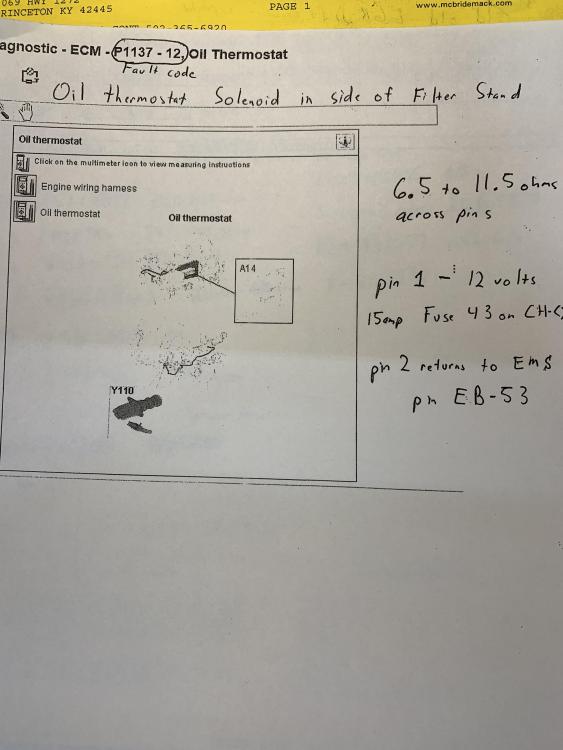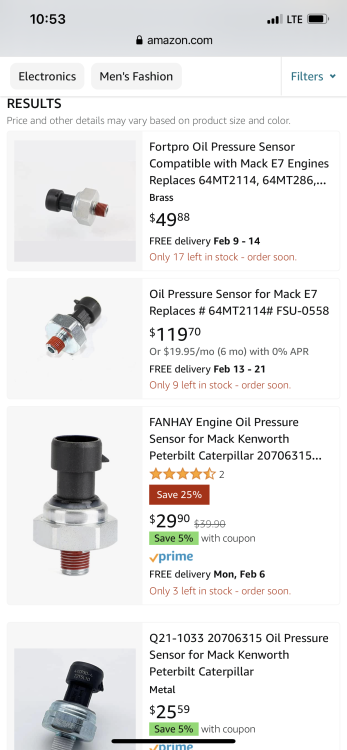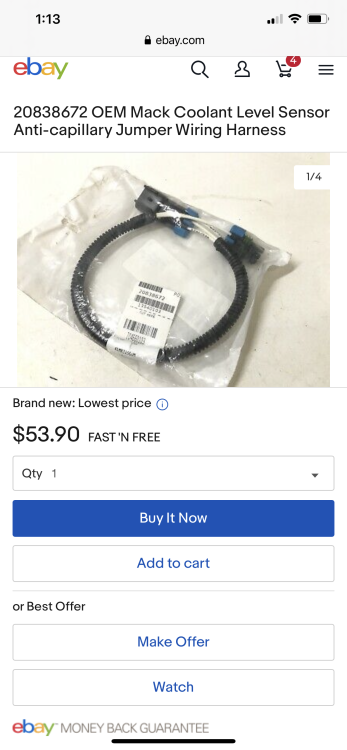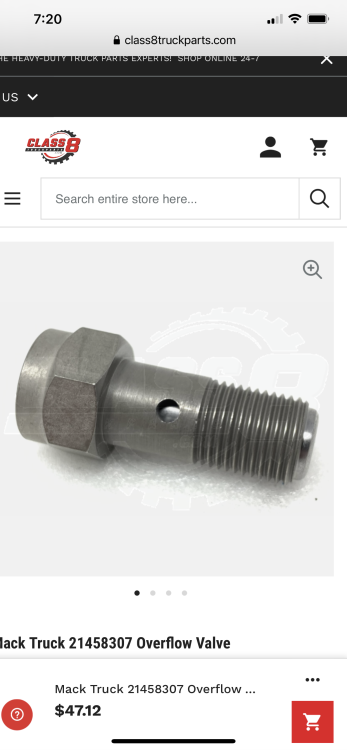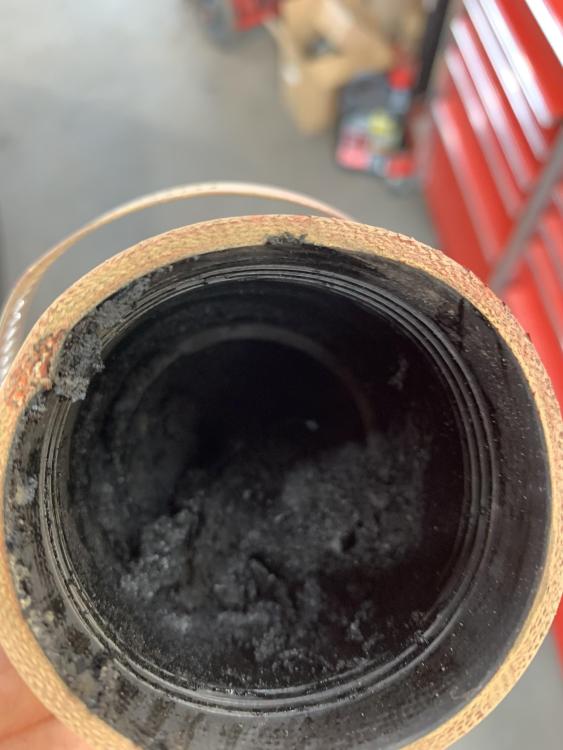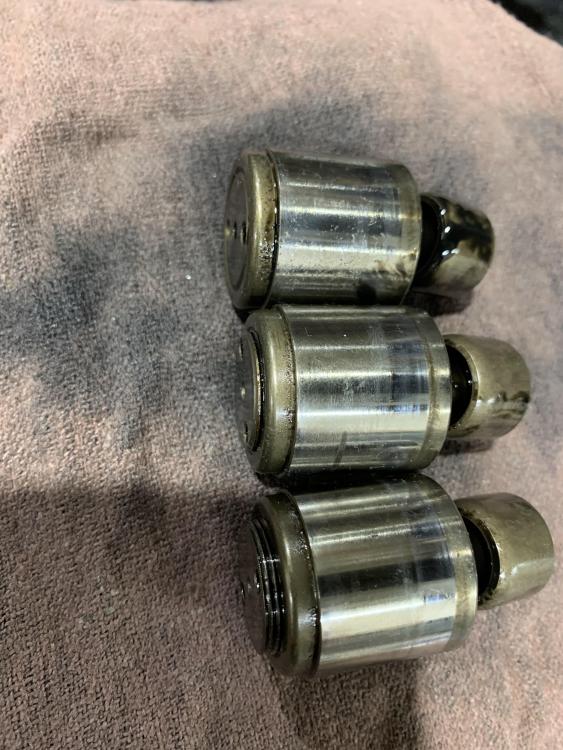
Mackpro
BMT VIP-
Posts
3,025 -
Joined
-
Last visited
-
Days Won
10
Content Type
Profiles
Forums
Gallery
Events
Blogs
BMT Wiki
Collections
Store
Everything posted by Mackpro
-
shut down light code 4812
Mackpro replied to steve r's topic in Modern Mack Truck General Discussion
I believe the fuse is in the fuse box down by where the clutch pedal is . I didn’t write that down in my notes -
shut down light code 4812
Mackpro replied to steve r's topic in Modern Mack Truck General Discussion
-
shut down light code 4812
Mackpro replied to steve r's topic in Modern Mack Truck General Discussion
The 2 oil solenoids on the oil filter stand should have 12 volts to them . They share the same fuse. If one shorts out bad enough to blow the fuse it sets the code for both solenoids. Wiring to the solenoids rubbing on the engine also can blow the fuse as well. Each has a wire that runs back to engine ECM . The engine ECM controls/grounds the return wires to close the solenoids independently. -
The early VMAC trucks had a coarse threaded sensor but all 1999 and up ETECHs I ever saw had the ( I called fine thread) 1/8” pipe thread sensor that I listed above. Amazon has them at various prices and qualitys! Lol
-
Original part number 64MT2114 , new number is 20706315 . It’s about $163 from the dealership
-
Try some of the Turbo/injector repair shops . We’re having to get injectors from them due a 4 month wait on certain Mack injectors ( 2008 & 2009 MP8). Some of the shops are certified Borg Warner shops and you might get lucky.
-
2000 ch613 Vin decoding
Mackpro replied to Justntymerepair's topic in Modern Mack Truck General Discussion
CH613 built 2/13/2000, came with a 460 ETECH engine, Fuller FRO16210C trans , Eaton DS462P forward drive axle and a Eaton RD462 rear rear drive axle both with 3.90 gears. -
When I worked at the dealership. Corporate wanted us to use Jpro for the initial code reading to determine if it was a possible quick fix or a more involved repair ( low coolant sensor vs a complex SCR issue). Jpro was way much faster than Tech Tool to connect and read codes, a lot faster. I did like the regen/after treatment screen on the JPro. On the Jpro we had, You could read and clear codes, view sensor readings and do regens but that was it. Now where I work we have Jpro but never use it. We go straight to Tech Tool because nothing is usually a easy fix anymore.
-
We replaced tons of CCV’s on MP7’s. The brass nipple that directed the oil to spray the spinner filter to make it spin would fall out which would at times blow oil out the blow by hose . Fun times .
-
True. And if you go all out and get it with software programing it’s basically the exact same thing as the dealership has.
-
2019 gu7 turn signals act crazy and check light comes up on dash at times
Mackpro replied to clpetty's question in Mack Truck Q & A
The the GR Granite. AN Anthem and PI Pinnacle all got the lovely LCM ( Light Control Module) that Volvo has been using many many years. The LCM has I think 6 or 7 fuses in the upper fuse panel on top of the dash . They are labeled LCM 1, LCM 2 and so on . No detail on which fuse does what functions of the LCM. It’s not to bad of a system except when someone decides to add lights or swap bulb type ( LED to regular bulb or the other way) and the worse is bed companies tapping into harnesses and overloading the circuits . If there is a plug at the very back of the truck . Unplug it and see if you can narrow it down to the bed lights . Pop out the lights on the bed on either side of the tail gate . If you have a high lift tailgate the cylinders and rams hidden inside sometime get into the wires . I honestly don’t know I’d the truck with the LCM’s still have a flasher or if it’s made into the LCM . -
Went to my buddies shop tonight and he just got the bootleg version of Tech Tool from somewhere on the Internet. Using his Nexiq USB link-2 adapter we could connect to the truck but that was it , couldn’t get past the first screen. I had my Mack VOCOM adapter and used it and could connect and read codes and regen but very very limited. He mainly wanted it to calibrate clutches in Mdrive and Ishift trans after doing clutch jobs. It does do that though if you have the Vcom adapter. He tried to call the guy he bought it from but the guy doesn’t speak English so he has to communicate through email . It’s not looking good .
-
Not really ever see any oil consumption issues with the MP engines. Has any major engine work ever been done to the engine? Have you changed to a different oil weight or brand lately? Mack is pretty specific on their oil rating . EOS-4.5/CK-4 is the recommendation rating . The MP7’s did have some CCV issues that blowed oil out and also low oil pressure warnings when in hot conditions but all that was fixed years ago. https://www.macktrucks.com/-/media/files/body-builder/manuals/heavy-duty/2022/mack-section-1--oil-and-filter.pdf?rev=3fe5689395524824988bae78e9d93183&hash=4A654651964E2CF482A1F80AB207CF46
-
97 ch 355/380 with rebuilt fuel pump
Mackpro replied to mack 50's topic in Modern Mack Truck General Discussion
I assume it’s a VMAC 2 electronic pump. Did you use the A/B timing light to time and install the pump? Some pumps time on #1 and some time on number 6 . There is a rack rod adjustment that can be done but the pump shop should have done that . -
2019 gu7 turn signals act crazy and check light comes up on dash at times
Mackpro replied to clpetty's question in Mack Truck Q & A
Are you sure it’s a GU and not a GR? Big difference in wiring . -
Don’t buy the bootleg version off Amazon or anywhere else. Two of my buddies bought them and most of the test don’t work and the troubleshooting was missing for a lot of the fault codes. Buy the real version. The base version for Mack is not to expensive. You can get it for Mack and Volvo or just Mack . You can also get it with software programming which is basically the dealership version, that way if any new software comes out for the any of the ECM’s you can update it instead of taking it to the dealership. Also go to the website and see what communication adapters they recommend. We always used the Mack VOCOM 1 or 2 but they are very expensive. I have used the cheaper Norgon DLA2 or Nexis but some of the testing or parameters programing might not work. It’s best to see what the website says. I will say it’s the most horrible and aggravating software I have ever used but it’s the only one that does it all on the MP engines.
-
Good find on that., Mack had a issue with the coolant level sensor leaking coolant into the wiring between the copper and insulation. The coolant would travel back into the engine ECM . One of the side effects was the dash cluster going out. Mack Service Bulletin SB237009 covers the issue. They came out with a jumper wire to go between the coolant level sensor and engine harness to block the coolant from getting to the ECm . Unplug your coolant level sensor abs see if it’s wet inside.
-
Egr fault mass flow to high
Mackpro replied to mdixon's topic in Modern Mack Truck General Discussion
There is a fuel pressure relief valve on the front of the head . More towards the driver side of head . It’s more like a banjo fitting that goes through a fuel line that runs back down to the fuel filter stand. The original valve was hex headed all the way to the end of the valve . The new updated valve is rounded on the end. Replaced lots of the old style valves for low fuel pressure issues. I don’t know the date the new valve came into production but somewhere between 2012-2014. Top pic is old style . Bottom pic is new style . -
Egr fault mass flow to high
Mackpro replied to mdixon's topic in Modern Mack Truck General Discussion
On the EGR differential pressure. Ive noticed on the new updated sensor with the new style Venturi pipe. During a regen using Tech Tool I see the pressure spikes that you talk about. It happens only for a second. I thought I had a bad sensor so replaced it and still same split second spike. I noticed it on several trucks. -
Egr fault mass flow to high
Mackpro replied to mdixon's topic in Modern Mack Truck General Discussion
MP fuel pressure should be 55 psi idle and 65 psi at 1100-1200 rpm( regen speed). I’ve seen it lower but during a regen 57-58 psi would be my low limit. I’d be changing fuel filters, cleaning out fuel line banjo fittings and checking fuel pressure relief valve in the head. And the fuel shutoff valve/AHI fuel pressure should be the same as engine pressure when activated. -
On the common rail engines there are 3 types of regens ( possibly 4) that you can do using Tech Tool . A Soot regen and a Sulfur regen and a Crystal Sublimation regen. I’ll see if I can find out if possibly one of the others need to be done instead of the regular soot regen .
-
I just deleted a post here as I was forgetting which truck I was referring to . I talked to some guys today at the dealership. They are having a rash of EGR coolers cracking and or clogging on the 2019 to 2021 MP8 trucks . Both in the GR and Anthem trucks . 4 in the last month or so. I wonder if this could a issue. I can’t remember if you posted if the engine software was up to date.
-
Egr fault mass flow to high
Mackpro replied to mdixon's topic in Modern Mack Truck General Discussion
When was the valves adjusted last ? I had this MP8 a while back and had low power and constant regen requests. 2012 was the last time the valves were adjusted. Engine brake plungers unscrewed themselves and caused some weird issues. This can happen on all pre-common rail engines. Top one is flush, middle one is starting to back out and bottom one is way out. Mack sent out tools to all the dealers to tighten and loctite them -
Egr fault mass flow to high
Mackpro replied to mdixon's topic in Modern Mack Truck General Discussion
In my notes for your model . The fuel doseing rate should be between 5% to 19% to be normal. Your is at 12% which is perfect. 22-29% usually mean clogged 7th injector. This is only for your year model. Other years are much higher. With the key on/engine off , what is your EGR differential pressure? And also what is the DPF differential pressure reading key on/engine off? -
The first few years of the common rail the removed the fuel pressure sensor from the filter stand. Only way you could view it was by looking at the AHI fuel pressure sensor ( all in the filter stand now). Finally Mack/Volvo gave in and started putting a fuel pressure sensor back on the filter stand. I also thought if the EPRV had not already been deleted, what would happen is the EPRV was stuck open?
BigMackTrucks.com
BigMackTrucks.com is a support forum for antique, classic and modern Mack Trucks! The forum is owned and maintained by Watt's Truck Center, Inc. an independent, full service Mack dealer. The forums are not affiliated with Mack Trucks, Inc.
Our Vendors and Advertisers
Thank you for your support!


